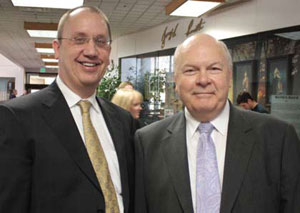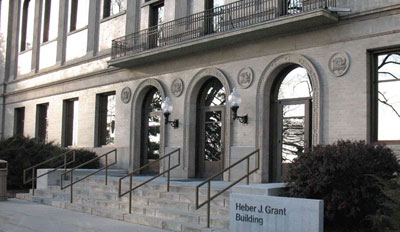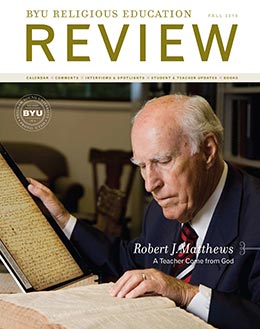In Review: Ten Years at the RSC
Brent R. Nordgren
Brent R. Nordgren (brent_nordgren@byu.edu) was the production manager at the Religious Studies Center when this was published.
As Richard Holzapfel was preparing to leave BYU to begin his service in the Alabama Birmingham Mission, I asked him to reflect on his ten years at the Religious Studies Center (RSC). His assignment began in 2000 when Religious Education dean Robert L. Millet decided to create a new publication, the Religious Educator (RE), to provide faculty members another venue in which to publish their research. There has always been a challenge for Latter-day Saints who want to explore Mormon life in a context of faith and scholarship to find an appropriate venue to publish their work, and the creation of the RE has proved to provide such an outlet.

Dean Millet approached Richard when Andy Skinner was putting together the first issue in the deans’ office and said, “We want to go forward with this journal. Would you become the editor?” Richard accepted the assignment and soon thereafter moved from his office in the Joseph Smith Building (JSB), the home of Religious Education on campus, into the Heber J. Grant Building (HGB), where the Religious Studies Center is housed.
As he began to consider what he might do with the journal, he immediately thought of Ted D. Stoddard, who taught business writing in the Marriott School of Business and was an excellent editor with lots of experience. Next he thought of getting a professional designer to create a format and template for the journal. He contacted Stephen Hales of Hales Creative in Provo. Without hesitation, both accepted the offer to help launch the new journal.
Together, Richard, Ted, and Steve set out to find a niche that would enhance gospel scholarship and teaching without duplicating the excellent efforts at BYU Studies or the Ensign. The target audience, identified by Dean Millet and the Religious Education Administrative Council, was seminary and institute teachers, religion professors, and Church teachers who taught Relief Society, priesthood, and Sunday School (Gospel Doctrine).
Eventually, they settled on three basic types of articles to form the core content. First, they decided to include scriptural and scholarly articles written by experts in their fields. Second, they incorporated excellent pedagogical articles—teaching people how to fish instead of just handing them a fish. The third type of article was personal essays—helping readers personally as individuals. For example, one essay discusses preparing for the inevitable reality of death (see M. Steven Andersen, “Now That You’ve Planned for the Contingencies, Plan for the Inevitable,” RE 10, no. 1 [2009]: 113–21).
Shortly after the first two or three issues, it was obvious that an important niche was filled. Overnight the subscriptions increased significantly, mostly from full-time seminary and institute teachers. Richard knew he had discovered the right formula but still needed to fine-tune it—a process that continues today.
The first volume consisted of one issue (produced in the deans’ office at the time Richard accepted the assignment to become the editor); the second volume consisted of two. Eventually, Richard added a third issue each year focusing on the upcoming seminary curriculum year. This required cooperation from the Church Educational System’s central office and has been a very successful addition, providing seminary and institute teachers opportunities to publish.
Richard had another important goal: he wanted to identify people outside of BYU Religious Education who would be willing to volunteer their time to serve on an advisory board, ensuring that the journal was on track and that the authors were not just speaking to themselves. The board eventually included individuals beyond BYU campus living as far away as New Zealand and throughout the United States and Canada. Eventually, this advisory board accepted having its duties expanded to the entire RSC.

The work at the RSC expanded to include publishing the proceedings of the annual Religious Education Student Symposium. These papers go through the blind peer review process and are published in a book. It has been a marvelous way of mentoring students in both their research and their publication efforts.
Richard’s role expanded at the RSC when Richard Draper, the RSC publications director, became associate dean in 2004. Holzapfel was invited to wear both hats for a short time, as publications director and Religious Educator editor, while the Administrative Council looked for someone to take over the RE. For a number of reasons that did not happen, and eventually Richard was asked to fill both faculty positions permanently. Without the help of Devan Jensen, the executive editor at the RSC, this could not have happened. But still, the RSC was one faculty member short, forcing Richard to adapt. The first thing he did was to combine the two operations so that all of the RSC student editorial interns worked on both the journal and the books. This gave the students a broader range of editing experience and eliminated downtime because there was now a continual flow of books and journal articles. As production increased, the RSC was able to hire a part-time production person to help carry part of the load. This position eventually became full-time as the RSC continued to increase its responsibilities and productivity.
Independent of Richard’s responsibilities at the RSC, Richard and Thom Wayment proposed hosting an Easter Conference to help celebrate that transcendent day. The university approved it. The first one was held at the BYU Center in Salt Lake City with Elder D. Todd Christofferson as the keynote speaker. It was a complete success, so they thought, “Well, let’s do it again.” The second Easter Conference was held on campus in the Joseph Smith Building auditorium. It attracted about nine hundred attendants. Speakers included President Cecil O. Samuelson, president of the university; John S. Tanner, the academic vice president; and a number of faculty members. What had originally been a single event was approved to become an annual event. Today the conference includes one keynote speaker and two faculty presentations with inspirational musical numbers to highlight the significance of the event. About this same time, the RSC took the lead in sponsoring and executing the conference and in publishing the presentations in a series of books.
In 2006 the RSC program expanded again when Alexander L. Baugh proposed the idea of a Church History Symposium. Most years it was well attended and produced some thoughtful presentations and an accompanying book was published by the Religious Studies Center. After the 2014 symposium it was reduced to an every-other-year event.
In 2007 the dean asked Richard to attend a meeting where he was asked if his office could help on another initiative. Dean Ball asked, “Would you be willing to house Studia Antiqua in the Religious Studies Center?” The RSC would offer a student editor internship for this student journal dedicated to ancient studies. Additionally, they would help with its production. Originally started by BYU student Matthew Grey, one of Richard’s research assistants in 2001, the journal had alternately thrived or suffered based on the time the student editor would donate and the ability to get financial support for its production. Religious Education and other colleges, departments, and institutes were interested in ensuring the journals’ survival as a means of allowing students experiences usually reserved for faculty—research, writing, and publishing. The decision to provide a paid internship and a facility with a computer and mentoring opportunities was considered the best way to support students in their effort to gain valuable experiences at BYU before going to graduate school.
Later that year, Richard proposed changing the format of the RSC Newsletter to a full-color magazine to be called BYU Religious Education Review. This magazine built upon and expanded on earlier efforts to provide information about the RSC’s activities—including highlighting current research initiatives. What Richard envisioned was something bigger than the RSC Newsletter—a voice of Religious Education, including the departments of Church History and Ancient Scripture, plus the RSC, highlighting students, faculty, staff, and administration at Religious Education. The response has been very favorable.
Richard continued to think about ways the RSC could reach a greater audience in an effort to bless not only the campus community but also the Church. For some time he felt that several excellent articles and books had been published over the years at the RSC. Yet he knew that many of them were long out of print. He felt it was a shame to have invested so much time, effort, and resources just to have them unavailable. Some RSC classics could be found at rare and out-of-print bookstores but were rather expensive. So Richard proposed creating an RSC Web site that could be a place to post articles and books as part of an effort to expand the audience well beyond its previous reach.
The Lord promised that all will hear the gospel in their own language (see D&C 90:11), and part of our purpose at BYU is to allow members of the Church access to the very best talks and articles given here. In 2008, with approval from the Religious Education Administrative Council, the RSC embarked on a project to put the complete RSC library on its website, including translation into other languages. If the whole RSC publication library could be on the website for free, the original research efforts of the authors would be given a second life. Richard realized he did not have the resources to translate everything published into every language Church members speak, but he recognized that translating the English text into Spanish and Portuguese would give as much as 60 to 70 percent of the Church the opportunity to access the RSC publications. The Internet allows the RSC to share the gospel beyond the four walls of a classroom and beyond the limited print run of a book. Richard noted, “In fact, last year we discovered that in a single month people from seventy-seven nations visited the site.”
Also in 2008, John Tanner invited Richard, as publications director, to be part of the Council on Religious Endeavors (CORE). This council oversees the BYU Press imprint, funds research for various religious projects, and coordinates religious conferences, exhibits, lectures, and publications. The following year, the RSC was asked to coordinate the books that will bear the BYU Press imprint. The RSC now maintains the BYU Press Web site and coordinates with other publication units on campus to publish the best books on campus. Richard initiated and oversaw the remodeling of the RSC facility in the HGB to create an office space for the additional personnel, making it a premier publication office perfectly suited to its current assignment.
In the past ten years the RSC has witnessed an expanded role and an expanded audience. Building upon a solid foundation established when the RSC consisted of only a director, a secretary, and a few student interns, publishing two or three excellent books and a newsletter each year, the RSC is now a beehive of activity that publishes ten to twelve books a year, a journal published three times a year, and a full-color magazine published twice a year. For three of the past four years, RSC books have earned awards from the Mormon History Association (MHA). The RSC received the award for best documentary history in 2007 and best publication in international Mormon history in 2009 and 2010. Additionally, the RSC plans and hosts the annual Church History Symposium and Easter Conference. It facilitates the publication of the annual Sperry and Student symposiums. It maintains a Web site in multiple languages, providing members of the Church around the world access to BYU.

Reflecting on his time at the RSC, Richard said, “One day I was sitting in my new office in the HGB and thought, ‘I don’t know who was here twenty or thirty years ago.’ It was a defining moment for me, realizing that in another twenty or thirty years into the future somebody else will be sitting here and will not remember that I served here as the publication director of the RSC. It became clear that the RSC must not be personality driven so that our contributions will live on beyond the individual contributor. Over the last ten years every person involved in the Religious Studies Center—whether a contributing author, donor, symposium attendee, or publications director—has been building the Religious Studies Center piece by piece. The new RSC leaders will stand on our shoulders and see things we did not see, and they will make changes and adjustments, and that is exactly the plan. We need to adapt and change to meet the needs of an ever-growing international Church.”
He added, “There are two sets of clients in the Religious Studies Center. The first clients are the contributors—the people who send in their hard work, their thoughtful essays, hours of research and thinking and writing and presentation. The second clients are the people who come to the conferences, who look at the Web site, who read the articles. They are members of the Church and members of other faiths. They are professors at universities, and they are new members teaching Relief Society or Sunday School in a small branch in Michigan, Wales, or Brazil. So we try to meet their needs to facilitate the great work. We are trying to bring together the best people to inspire us, to teach us doctrinal content, to teach us how to be better teachers, and ultimately to inspire confidence in the Restoration, so that we can answer the basic questions of life and, by study and by faith, do what the Lord wants us to do. And so we bring the Spirit, the revelation, the testimony, and the faithfulness together to become disciple-scholars, exercising full faith in the Restoration but also using our intellect to contemplate the Lord’s revelations and the new discoveries and the important implications. Archaeological discoveries and newly uncovered historical documents allow us to look at the story of the Restoration through new lenses. And the Religious Studies Center is one of many good institutions providing thoughtful insights into this marvelous story.”
